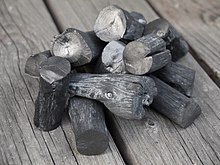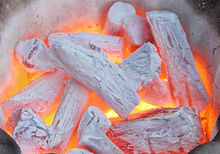Binchō-tan or white charcoal or binchō-zumi (備長炭) is a traditional charcoal of Japan. It dates to the Edo period when during the Genroku era, a craftsman named Bichū-ya Chōzaemon (備中屋 長左衛門) began to produce it in Tanabe, Wakayama. The raw material is oak, specifically ubame oak (Quercus phillyraeoides), now the official tree of Wakayama Prefecture. Wakayama continues to be a major producer of high-quality charcoal, with the town of Minabe, Wakayama producing more binchō-tan than any other town in Japan. Binchōtan is a type of Lump charcoal or Hardwood charcoal.


Binchō-tan / white charcoal
The fineness and high quality of binchō-tan are attributed to steaming at high temperatures (about 1000 degrees Celsius). Although it is often thought that binchō-tan burns hot, it actually burns at a lower temperature than ordinary charcoal but for a longer period, making it preferable to a number of Japanese chefs. Because it does not release smoke or other unpleasant odours, it is a favorite of Unami (freshwater eel) and yakitori (skewered chicken) cooks. Due to difficulties in identifying the producing region, the name binchō-tan has come into broader use to designate white charcoal generally, and even products from outside Japan, as well as those made of other species, have come to use the name.
To differentiate the aforementioned "non-pure" products, there is a movement to call binchō-tan produced in Wakayama kishū binchō-tan.


Burning Binchōtan
Binchō-tan has found uses other than as a fuel. Because it has numerous small pores, it can absorb chemical substances. Bits can be added to rice during cooking to remove the chlorinated tap water taste, placed in shoe-cabinets to absorb odors, and put in rooms to freshen the air. There are many more supposed benefits and health values of white charcoal. Currently there are a number of binchō-tan-based consumer products on the market such as socks, shirts, shampoo, cosmetic products, and many more. Acclaimed London yakitori restaurant Bincho takes its name from binchō-tan.
Binchō-tan or white charcoal is harder than black charcoal, and rings with a metallic sound when struck. Wind chimes and a musical instrument, the tankin ("charcoal-xylophone") have been made from it.
- Wikipedia





Activated charcoal can do these various things because of its ability to attract other substances to its surface and hold them there. This is called “adsorption” (not absorption). Another one of the benefits of activated charcoal is that it can adsorb thousands of times its own weight in harmful substances. One teaspoonful of it has a surface area of more than 10,000 square feet. charcoal medicinal uses
ReplyDelete